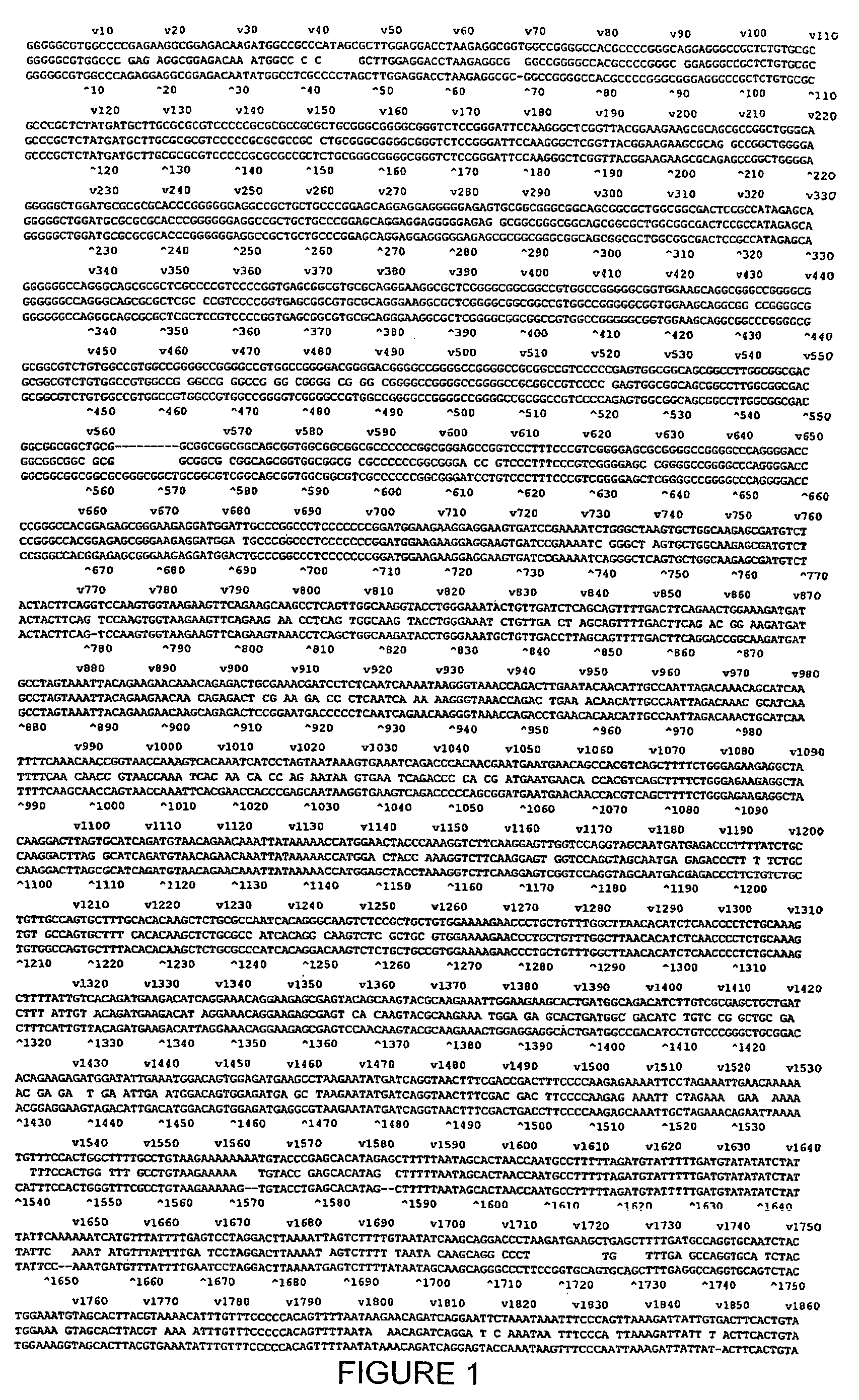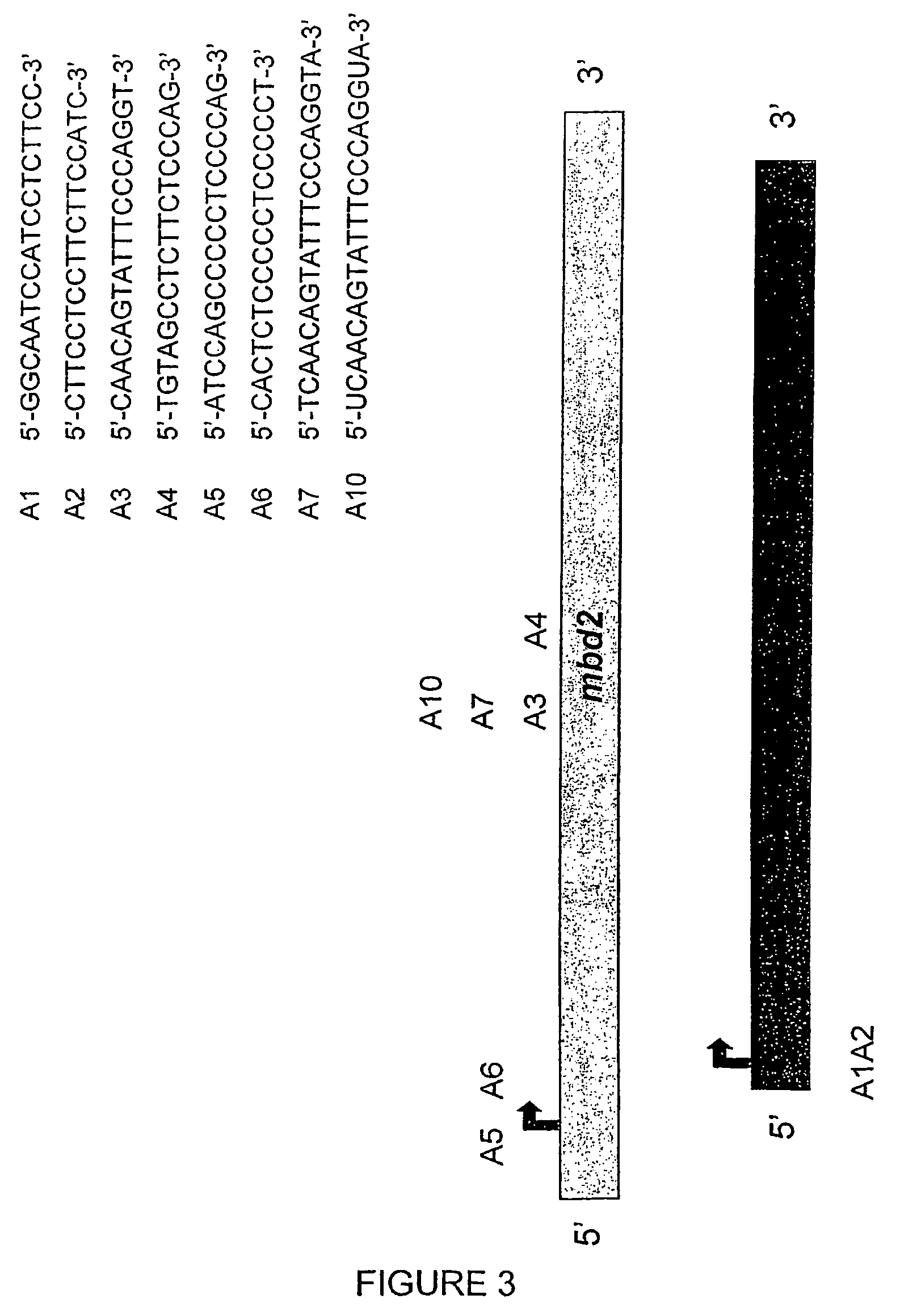Oligonucleotide inhibitors of MBD2/DNA demethylase and uses thereof
a technology of oligonucleotide inhibitors and dna demethylase, which is applied in the field of cancer therapy, can solve the problems of limited use in vivo of large expression constructs, and achieve the effect of inhibiting the proliferation of cancer cells
- Summary
- Abstract
- Description
- Claims
- Application Information
AI Technical Summary
Benefits of technology
Problems solved by technology
Method used
Image
Examples
example 1
Inhibition of mbd2 / dMTase mRNA Expression by Antisense Oligonucleotides
[0148]A. To screen and test antisense inhibitors of MBD2 / dMTase, the human non-small cell lung carcinoma cell line A549 (ATCC# CCL-185), which expresses high levels of MBD2 / dMTase, was treated with 200 nM of either the selected antisense oligonucleotide or a scrambled control. Lipofectin (6.25 μg / ml) was used as the lipid carrier. The cells were treated twice (0 and 24 h) and harvested 48 h post treatment (see protocol in B).[0149]To determine whether the treatment with the antisense compound results in reduction of MBD2 / dMTase levels, total mRNA was isolated from the cells and used to perform a Northern blot analysis. A 32P-labeled cDNA probe was used for hybridization. The signal obtained with the specific probe was normalized to total RNA in the lane as determined by hybridization with an 18S rRNA-specific oligonucleotide probe (see protocol in B). The results for antisense oligonucleotides A3, A4, A5, A6 and ...
example 2
Inhibition of Anchorage-Independent Growth of Cancer Cells by Antisense Oligonucleotides to mbd2 / dMTase
[0152]A human non-small cell lung carcinoma cell line A549, which expresses high levels of MBD2 / dMTase, was treated with increasing concentrations of either the selected antisense oligonucleotide A10 or a reverse scrambled control oligonucleotide A11 for 48 h. An equal number of live cells were plated onto 0.33% agar with enriched medium. Colonies growing in an anchorage independent manner were counted by visual examination 3 weeks after plating to determine the anti-tumourigenic activity of the compounds. Anchorage-independent growth is an indicator of tumourigenicity. Results are shown in FIG. 5.
[0153]Similar experiments were conducted using the human colorectal carcinoma cell line HCT116. Cells were treated with either 200 nM of the MBD2 / dMTase antisense oligonucleotide A10 or the reverse scrambled control A11 for 48 h and were then plated onto soft agar. Colonies growing in an ...
example 3
[0156]For anchorage-dependent cell growth experiments, A549, HCT116, and MRHF cells were plated at the concentration of 50,000 cells / dish. After 24 hours, cells were treated with 200 nM of control oligonucleotide A11 or antisense oligonucleotide A10. Treatments were repeated after 24 h and cells were harvested 24, 48 and 72 h after the second treatment (Day 1, Day 2, Day 3, respectively). Cell viability was measured by trypan blue exclusion. Results are shown in FIG. 16A-C.
[0157]To determine cell cycle kinetics, the cells were fixed for 18 h in 70% ethanol at 4° C., and treated with propidium iodide to label DNA (Vindelov, L. L., and Christensen, I. J. (1988) Eur J Haematol Suppl 48, 69-76). Twenty thousand cells were sorted in triplicate for DNA content in a Becton Dickinson (Franklin Lakes, N.J.) FACScan cell sorter and data were acquired by the LYSIS II program Results are shown in FIG. 16D and indicate that antisense oligonucleotide A10 does not affect cel...
PUM
| Property | Measurement | Unit |
|---|---|---|
| pH | aaaaa | aaaaa |
| pH | aaaaa | aaaaa |
| pH | aaaaa | aaaaa |
Abstract
Description
Claims
Application Information
 Login to View More
Login to View More - R&D
- Intellectual Property
- Life Sciences
- Materials
- Tech Scout
- Unparalleled Data Quality
- Higher Quality Content
- 60% Fewer Hallucinations
Browse by: Latest US Patents, China's latest patents, Technical Efficacy Thesaurus, Application Domain, Technology Topic, Popular Technical Reports.
© 2025 PatSnap. All rights reserved.Legal|Privacy policy|Modern Slavery Act Transparency Statement|Sitemap|About US| Contact US: help@patsnap.com



